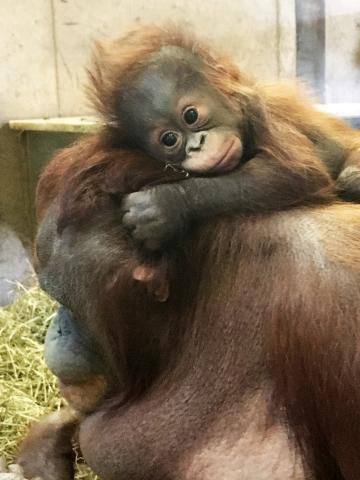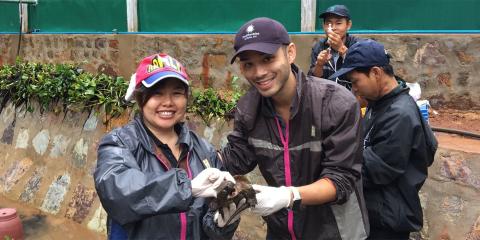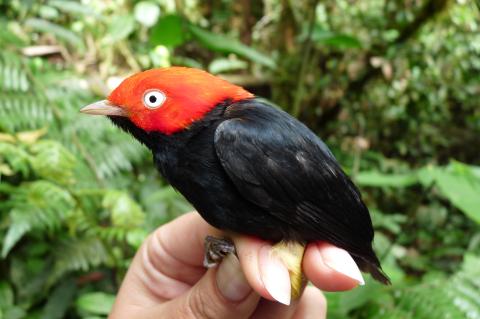News Archive
Filter By
- Abyssinian ground hornbill
- Addax
- Aldabra tortoise
- Allen's swamp monkey
- Alpaca
- American alligator
- American avocet
- American bison
- American flamingo
- American wigeon
- Andean bear
- Aquatic caecilian
- Arapaima
- Asian elephant
- Asian small-clawed otter
- Asian water dragon
- Australian snake-necked turtle
- Bald eagle
- Baltimore oriole
- Barred owl
- Beaver
- Bennett's wallaby
- Binturong
- Black-and-white ruffed lemur
- Black-and-white warbler
- Black-crowned night heron
- Black-footed ferret
- Black-tailed prairie dog
- Black-throated blue warbler
- Blue-billed curassow
- Blue crane
- Bobcat
- Brown pelican
- Bufflehead
- California sea lion
- Canvasback
- Cedar waxwing
- Channel catfish
- Cheetah
- Chicken
- Chinese alligator
- Chinese three-striped box turtle
- Clouded leopard
- Collared brown lemur
- Common raven
- Common yellowthroat
- Corals and sea anemones (anthozoa)
- Cow
- Crocodile monitor
- Cuban crocodile
- Dama gazelle
- Degu
- Dunlin
- Eastern indigo snake
- Eastern newt
- Eastern red-backed salamander
- Eastern screech-owl
- Eld's deer
- Electric eel
- Emperor newt
- Emperor tamarin
- Fennec fox
- Fishing cat
- Gaboon viper
- Geoffroy's marmoset
- Gharial
- Giant leaf-tailed gecko
- Giant panda
- Goat
- Golden-headed lion tamarin
- Golden lion tamarin
- Gray seal
- Gray wolf
- Green tree python
- Grevy's zebra
- Guam kingfisher (sihek)
- Guam rail (ko’ko’)
- Guinea pig
- Harbor seal
- Hartmann's mountain zebra
- Hawk-headed parrot
- Hellbender
- Home's hinge-back tortoise
- Hooded crane
- Iranian fat-tailed gecko
- Japanese giant salamander
- King vulture
- Komodo dragon
- Kori bustard
- Kunekune pig
- Land hermit crab
- Larger Malay mouse-deer
- Lemur leaf frog
- Lesser kudu
- Lesser Madagascar hedgehog tenrec
- Linné's two-toed sloth
- Lion
- Loggerhead shrike
- Long-tailed chinchilla
- Maned wolf
- Meerkat
- Miniature donkey
- Naked mole-rat
- North American porcupine
- North American river otter
- Northern Luzon giant cloud rat
- Northern pintail
- Northern red salamander
- Northern snakehead fish
- Northern tree shrew
- North Island brown kiwi
- Norway rat
- Orangutan
- Orchard oriole
- Ossabaw Island hog
- Ostrich
- Ovenbird
- Pallas's cat
- Panamanian golden frog
- Patagonian mara
- Persian onager
- Philippine crocodile
- Prehensile-tailed porcupine
- Prevost's squirrel
- Przewalski's horse
- Pygmy slow loris
- Red-crowned crane
- Red-fronted lemur
- Red-rumped agouti
- Red-winged blackbird
- Red knot
- Red panda
- Red River hog
- Red ruffed lemur
- Red wolf
- Ring-tailed lemur
- Ruddy duck
- Schmidt's red-tailed monkey
- Scimitar-horned oryx
- Screaming hairy armadillo
- Semipalmated plover
- Semipalmated sandpiper
- Siamang
- Sitatunga
- Sloth bear
- Southern lesser galago
- Southern swamp sparrow
- Southern tamandua
- Spider tortoise
- Striped skunk
- Swainson's thrush
- Tanagers
- Tentacled snake
- Tiger
- Titi monkey
- Turkey
- Twig catfish
- Vietnamese mossy frog
- Virginia opossum
- Von der Decken's hornbill
- Western lowland gorilla
- White-cheeked gibbon
- White-faced saki
- White-naped crane
- White-nosed coati
- Whooping crane
- Yellow-breasted chat
Displaying 1301 - 1325 of 2351 articles.
Smithsonian’s National Zoo To Build “Experience Migration” Exhibition Dedicated to Migratory Birds
The Smithsonian’s National Zoo and Conservation Biology Institute is transforming its historic 1928 Bird House into “Experience Migration,” a state-of-the-art exhibition about one of the most spectacular stories in the natural world—the migration of birds in the Western Hemisphere. “Experience...

Bornean Orangutan Redd's Social Circle is Growing
What has the Zoo’s 10-week-old Bornean orangutan, Redd, been up to? His social circle is expanding, says keeper Erin Stromberg, and his personality and curiosity are starting to develop! Get the latest on Redd and his mom, Batang, in the latest keeper Q&A.
Giant Panda Cub Bei Bei Recovering from Successful Bowel Surgery
Smithsonian’s National Zoo’s giant panda cub Bei Bei is stable and recovering following an emergency bowel obstruction surgery to remove a dense, masticated lemon-sized mass of bamboo.
Orangutan Caring Week
Happy Orangutan Caring Week! We’re celebrating the Zoo’s seven orangutans by sharing their stories. Redd Update Here’s lookin’ at you, kid! At 8 weeks old, our Bornean orangutan Redd is alert, attentive and making eye contact with those around him. His social circle is expanding, too. Earlier this...

Bei Bei's Growing Up
Bei Bei is becoming more and more independent from his mother Mei Xiang every day. It is hard to believe, but the time is rapidly approaching when he will live separately from her. He has a voracious appetite, and relies very little on milk from Mei Xiang. He weighs 90 pounds (the largest of Mei...
First Wild Horse Born From Artificial Insemination Moving From the Smithsonian Conservation Biology Institute
The first Przewalski’s (cha-VAL-skee) horse born from artificial insemination moved from the Smithsonian Conservation Biology Institute (SCBI) to the Dakota Zoo in Bismarck, N.D., today, Nov. 21. The move is based on a breeding recommendation. The mare, Christine, was born July 27, 2013, and her...

Turtle Survival Alliance: Big-Headed Turtle Confiscation in Myanmar
On Nov. 7 2016, approximately 800 big-headed turtles ( Platysternon megacephalum) were confiscated from Chinese traders arrested in Tachileik, Myanmar. Dr. Marc Valitutto of Smithsonian Global Health, stationed in Myanmar to conduct pangolin health research, was called upon to provide lifesaving...
Elderly Gray Seal Dies at the Smithsonian’s National Zoo
The Smithsonian's National Zoo’s senior female gray seal, Selkie, died today. At 43 years old, Selkie was the oldest gray seal living in human care. The lifespan of a wild gray seal is usually 25 or 30 years. Typically, female gray seals in human care can live close to 40 years; male seals live...
Vote to Name the Agouti Baby
The Smithsonian National Zoo's new agouti needs a name and we need your help! As mom is “Hazelnut,” dad is “Pistachio” and sibling #1 is “Coconut,” the new agouti will help complete the mixed “nut” exhibit at the Small Mammal House. Native to South America and similar in appearance to a Guinea pig...
Preparing for the Second Release of Scimitar-Horned Oryx to the Wild in Chad
I traveled to the United Arab Emirates in early October to work on the second release of Scimitar-horned Oryx with our collaborators from the Environment Agency—Abu Dhabi (EAD). Scimitar-horned oryx are a desert antelope native to Northern Africa. The first release was completed over the summer when...

What Sound Does a Forest Make?
SCBI's Center for Conservation and Sustainability is in Peru's Amarakaeri Communal Reserve recording how life is responding to an area of the forest designated for natural gas exploration. Researchers Tremaine Gregory and Jessica Deichmann give us the scoop on their findings in this Science Q&A.
Media Advisory: ZooLights, Powered by Pepco, Returns to Smithsonian’s National Zoo
ZooLights, powered by Pepco, at the Smithsonian’s National Zoo is wilder than ever and a perfect holiday event for families. Hosted by Friends of the National Zoo, the festival will run over 35 days and features thousands of environmentally friendly LED lights.
Male Andean Bear Cisco Dies at the Smithsonian's National Zoo
A 23-year-old male Andean bear named Cisco died at the Smithsonian’s National Zoo Oct. 24 during an emergency veterinary exam. In the past week, Cisco became less active and began breathing more heavily with an occasional cough. Those signs worsened over the weekend and his appetite declined, which...
Giant Panda Bao Bao Moving to China Next Year
Giant panda Bao Bao will depart the Smithsonian’s National Zoo for China in late winter, within the first few months of 2017.
Bao Bao's Departure FAQs
Read on for some of the most frequently asked questions about Bao Bao's departure.
Geriatric Sloth Bear Dies at the Smithsonian’s National Zoo
A 21-year-old female sloth bear named Hana was humanely euthanized at the Smithsonian’s National Zoo Monday, Oct. 17. In human care, sloth bears typically have a median life expectancy of early-to-mid 20s. Hana exhibited signs of lethargy and discomfort as well as a decline in appetite over the...
Zoo Improvement Collaboration in India
Smithsonian's Global Health Program is a contributor to the partnership between the Smithsonian’s National Zoo and Conservation Biology Institute and India’s Central Zoo Authority. This collaboration aims to share best-practices in veterinary medicine and diagnostics with zoos in India, which are...

Virus Detection in Myanmar's Bats
Smithsonian's Global Health Program (SGHP), through the U.S. Agency for International Development (USAID) PREDICT program, aims to strengthen developing countries’ ability to detect, control and prevent infectious diseases.
Vector Surveillance in Kenya's Camels
In Kenya, the Smithsonian Institution maintains a close collaboration with the Mpala Research Center and Ranch (MRC) located in Laikipia County.
